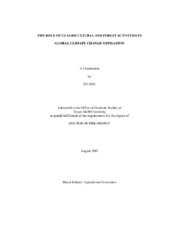| dc.description.abstract | In 2005 the highest global surface temperature ever was recorded. A virtual consensus exists today among scientists that global warming is underway and that human greenhouse gas (GHG) emissions are a significant cause. Possible mitigation of climate change through reduction of net GHG emissions has become a worldwide concern. Under the United Nation’s Framework convention on Climate Change, the Kyoto Protocol was formed in 1997 and required ratifying countries to co-operate in stabilizing atmospheric GHG concentrations. The protocol took effect on February 16, 2005. The mitigation cost for reducing GHG emissions for the US economy has been argued to be high particularly through the energy sector. Agriculture and Forestry (AF) can provide some low cost strategies to help with this mitigation principally through carbon sequestration but must be competitive with mitigation costs in the rest of the economy. A general equilibrium approach is used herein to evaluate the role of AF mitigation in an economy wide setting. The results show that the AF sectors have significant mitigation potential. Higher carbon prices lead to more sequestration, less emissions, reduced consumer and total welfare, improved environmental indicators and increased producer welfare. AF mitigation increases as the carbon price increase over time. In the earlier periods, while the carbon price is low, AF emissions and sink are quite small compared to the energy sector. As carbon prices increase over time, the AF sectors mitigate about 25% of the net emissions. This verifies McCarl et al's (2001) argument that the AF sectors “may be very important in a world that requires time and technological investment to develop low-cost greenhouse gas emission offsets.” AF GHG emission mitigation is sensitive to saturation of sequestration sinks. This research finds that ignoring saturation characteristics leads to a severe overestimate of mitigation potential with estimates being inflated by as much as a factor of 6. | en |


